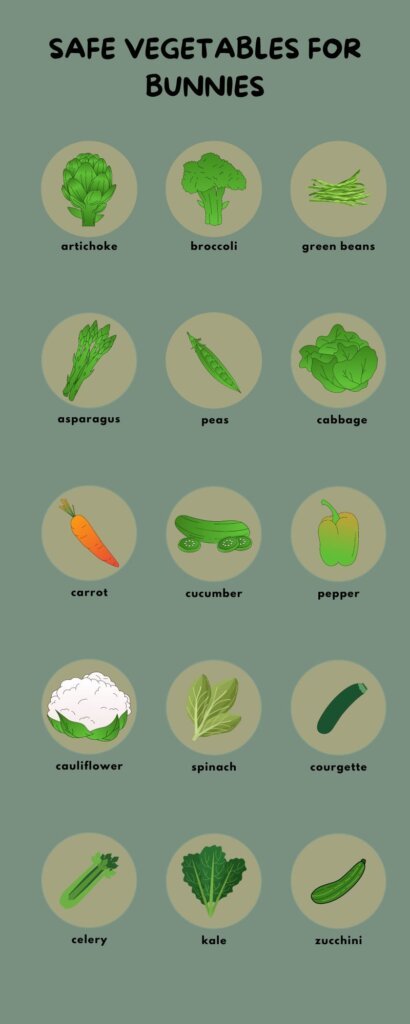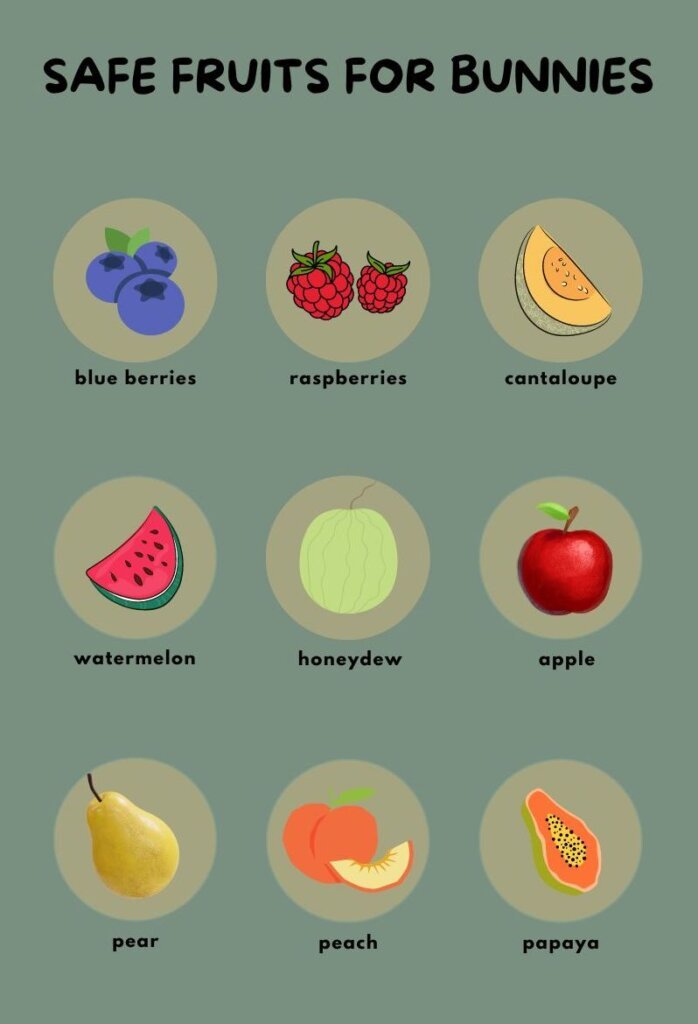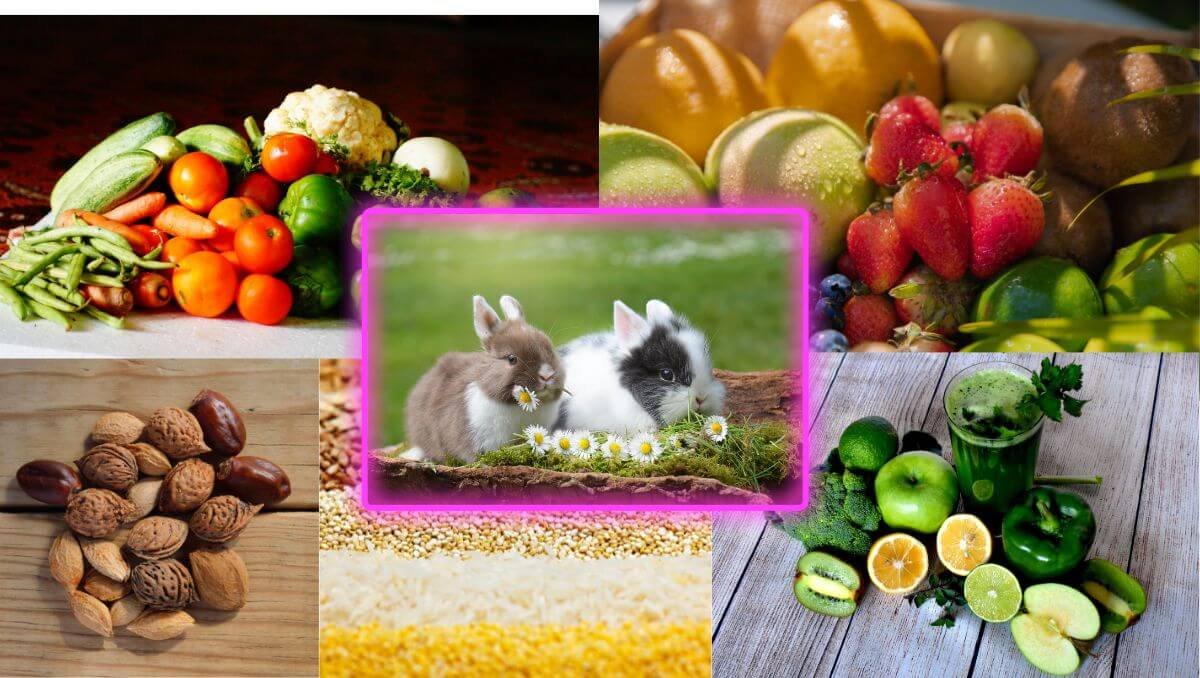Ever wonder what those curious glances your rabbit throws at your dinner plate mean? Perhaps they’re yearning for a taste of the exciting world beyond their usual hay and pellets. But before you share your culinary delights, let’s embark on a journey through “What Can Rabbits Eat?” to discover the safe treats, essential staples, and hidden dangers in their diet.
This guide dives into the intricate world of bunny nutrition, exploring the importance of a balanced diet, potential hazards, and responsible feeding practices. Join us as we navigate the diverse landscape of rabbit-friendly foods, understanding the best leafy greens, essential hay options, nutritious treats, and forbidden fruits to keep your furry friend hopping with happiness.
Here’s a sneak peek at what awaits you:
- Exploring the Foundation: Uncover the paramount role of high-quality hay and the vibrant world of safe leafy greens in building a healthy bunny.
- A Bountiful Garden Patch: Discover a colorful variety of safe vegetables and understand potential choking hazards and responsible fruit-feeding practices.
- Forbidden Feasts: Learn about toxic threats, processed perils, and why nuts are generally off-limits for your bunny’s sensitive digestive system.
- Responsible Feasting: Master the art of introducing new foods gradually, portion control, and ensuring proper hydration for your bunny’s well-being.
- Beyond the Plate: Dive into enriching activities, regular vet checkups, and the importance of informed pet ownership for a thriving bunny life.
So, are you ready to unlock the secrets of a healthy and delicious diet for your inquisitive bunny? Let’s hop in!
The Foundation of a Bunny’s Diet: Building Block by Block
A rabbit’s ideal diet isn’t just about occasional treats; it’s about building a strong foundation for their long-term health and happiness. Here are the essential building blocks:
Hay Haven
The cornerstone of every bunny’s diet is unlimited access to high-quality hay. Think of it as their nutritional powerhouse, offering essential fiber for gut health, preventing boredom, and naturally wearing down their continuously growing teeth. Opt for varieties like timothy, orchard grass, or oat hay for optimal nutrition.
Leafy Greens Galore
Next, add a splash of color and vitamins with safe leafy greens. Romaine lettuce, kale, spinach, and even herbs like parsley, cilantro, and basil are excellent choices. They’re packed with vitamins, minerals, and fiber, making them a delicious and nutritious addition to your bunny’s plate.
Remember: Introduce new leafy greens gradually and monitor your bunny for any digestive upset.
A Bountiful Garden Patch: Exploring Safe Vegetables
Now, let’s explore the exciting world of vegetables! While hay and leafy greens form the foundation, a variety of safe vegetables can add enrichment and essential nutrients to your bunny’s diet. Here are some delicious options:

Veggie Delights
- Bell peppers: All colors are safe and rich in vitamin C and antioxidants.
- Broccoli florets: Packed with vitamins C and K, they also provide a fun chewing experience.
- Green beans: Low in sugar and high in fiber, these are a healthy snacking option.
- Carrots : Offer small amounts as they’re higher in sugar.
- Celery stalks: Great for hydration and chewing, but limit due to its diuretic effect.
- Cucumber: Refreshing and low in calories, but don’t overdo it.
- Zucchini: Another hydrating option with beneficial vitamins and minerals.
- Asparagus: A tasty treat rich in vitamins and antioxidants.
While these vegetables are safe, remember:
- Choking hazards: Chop vegetables into bite-sized pieces, especially for younger bunnies.
- Seed removal: Remove seeds from vegetables like bell peppers and squash before offering them.
- Consult your vet: If you’re unsure about any vegetable, always consult your veterinarian.
But wait, there’s more! While vegetables offer a treasure trove of nutrients, it’s crucial to understand their complexities to ensure your bunny enjoys a safe and healthy feast.
In the next section, we’ll delve into the world of fruits, exploring their potential benefits and hidden dangers.
Sweet Treats, Wise Eats: Navigating the Fruity Landscape for Your Bunny
Fruits might seem like a natural treat for your furry friend, but offering them wisely is key. Remember, a rabbit’s digestive system thrives on high-fiber, low-sugar foods, and fruits fall on the opposite end of that spectrum. So, let’s delve into the world of “Fruity Feasts” with a responsible approach:

Occasional Indulgence
Think of fruits as occasional treats, not dietary staples. They can add some variety and enrichment to your bunny’s life, but moderation is crucial. Offer tiny portions no more than 1-2 times a week.
Safe and Sweet Picks
When it comes to safe options, stick to fruits naturally low in sugar:
- Berries: Blueberries, raspberries, strawberries are excellent choices.
- Melon: Cantaloupe, honeydew, watermelon offer hydration and sweetness in moderation.
- Apple: A small slice occasionally can be a treat, but be mindful of the higher sugar content compared to other options.
Sugar Dangers
Avoid fruits high in sugar like:
- Grapes: Their high sugar content can lead to digestive upset and even diarrhea.
- Bananas: Similar to grapes, they’re loaded with sugar and not suitable for regular consumption.
- Citrus fruits: Oranges, grapefruits, and tangerines are too acidic and can cause stomach problems.
Remember:
- Always wash fruits thoroughly to remove harmful bacteria and pesticides.
- Remove any seeds, pits, or stems that could pose a choking hazard.
- Monitor your bunny for any negative reactions after introducing a new fruit.
- Consult your veterinarian if you have any concerns about your bunny’s individual dietary needs.
By following these guidelines, you can ensure your bunny enjoys the occasional fruity treat without compromising their delicate digestive system.
But wait, there’s more! Our journey through your bunny’s diet doesn’t end here. While fruits can be a delightful addition, there are still hidden dangers lurking in the kitchen.
In the next section, we’ll explore the forbidden feasts your bunny should absolutely avoid, ensuring their long-term health and happiness.
Forbidden Feasts: Protecting Your Hoppy Friend from Culinary Dangers
Now that we’ve explored the bountiful garden patch of safe vegetables and sweet treats of fruits, let’s venture into the wilderness of forbidden feasts. Just like humans, bunnies have their own set of dietary no-no’s that can wreak havoc on their delicate digestive systems. Knowing these potential dangers is crucial for keeping your furry friend healthy and hopping with joy.
Toxic Threats
Some foods are downright toxic for rabbits and can even be fatal if ingested. Be extra cautious with these:
- Avocado: All parts of the avocado, including the flesh, pit, and leaves, are highly toxic and can cause serious health problems.
- Onions, garlic, and chives: These members of the allium family contain harmful compounds that can damage red blood cells and lead to anemia.
- Rhubarb: The leaves and stem of rhubarb contain oxalic acid, which is poisonous to rabbits.
- Iceberg lettuce: While not technically toxic, iceberg lettuce is low in nutrients and can cause diarrhea due to its high water content.
- Unripe fruit: Unripe fruits are often high in toxins and can cause digestive upset.
Processed Perils
Commercially available treats and human food scraps, even if they seem harmless, can be dangerous for rabbits:
- Sugary treats: Candy, cookies, and other sugary snacks can contribute to obesity, dental problems, and digestive issues.
- Human food scraps: Seasoned or processed foods contain unhealthy ingredients like salt, sugar, and artificial flavors that can harm your bunny’s sensitive system.
- Commercially available snacks (not formulated for rabbits): These often contain fillers, artificial ingredients, and high levels of sugar or fat, making them unsuitable for a rabbit’s diet.
Nutty Troubles
While some sources might suggest nuts as occasional treats, it’s generally best to avoid nuts for your bunny:
- Digestive Difficulties: The high fat content and complex nutrients in nuts can be difficult for rabbits to digest, leading to gas, bloating, or diarrhea.
- Choking Hazard: Small pieces or whole nuts pose a choking risk, especially for playful bunnies.
- Nutritional Imbalance: The high fat and low fiber content disrupts the essential fiber-based diet rabbits require.
By understanding these dietary dangers and keeping them off your bunny’s menu, you can ensure their long-term well-being and prevent potential health problems.
But the journey doesn’t end here! In the next section, we’ll delve into the art of responsible feasting, exploring tips for introducing new foods, portion control, and ensuring proper hydration for your bunny’s optimal health.
Responsible Feasting: Keeping Your Bunny Thriving on the Right Diet
Now that we’ve navigated the safe and forbidden foods for your bunny, it’s time to explore the art of responsible feasting. Remember, a healthy diet isn’t just about what you offer, but how you offer it. Here are some key practices to ensure your bunny gets the most out of their meals:
Introduce Slowly
Remember those curious glances at your plate? While tempting to share, resist the urge! Introducing new foods gradually is crucial. Start with tiny amounts and monitor your bunny for any signs of digestive upset like bloating or diarrhea. If all goes well, you can gradually increase the amount over several days.
Wash Thoroughly
Think your garden-fresh veggies are clean? Think again! Washing all vegetables and fruits thoroughly is essential to remove harmful bacteria and pesticides. Give them a good rinse under running water before offering them to your bunny.
Portion Control
Just like humans, bunnies thrive on portion control. The appropriate amount depends on your bunny’s size, age, and activity level. Consult your veterinarian for specific recommendations, but remember, hay should always be the main course, with veggies and fruits playing supporting roles.
Hydration Heroes
Fresh, clean water is vital for your bunny’s health. Ensure they have constant access to a water bottle or bowl and monitor their water intake. Dehydration can lead to serious health problems, so keeping them hydrated is key.
Beyond the Plate
A healthy diet is just one piece of the puzzle. Enrich your bunny’s life with stimulating activities like foraging toys, safe chew toys, and hiding treats around their enclosure. Regular vet checkups are also crucial to monitor their health and discuss any dietary concerns.
By following these responsible feasting practices, you can ensure your bunny enjoys a nutritious and enriching life, free from tummy troubles and full of happy hops!
Remember, informed pet ownership starts with responsible choices, and you’re well on your way to becoming a bunny-savvy pro!
Conclusion: A Nutritious Journey, a Hoppy Life: Your Role in Bunny Bliss
We’ve embarked on a delightful adventure, exploring the intricacies of your bunny’s dietary needs. We’ve unveiled the vibrant world of safe vegetables, the essential foundation of hay, the occasional indulgence of fruits, and the hidden dangers to avoid. Remember, knowledge empowers, and with this understanding, you’re equipped to make informed choices for your furry friend’s well-being.
Key Takeaways
- Balance is key: Prioritize high-quality hay, introduce safe vegetables gradually, and offer fruits as occasional treats, mindful of sugar content.
- Beware the forbidden: Steer clear of toxic foods, processed perils, and avoid nuts due to potential digestive issues and nutritional imbalance.
- Responsible feasting matters: Introduce new foods slowly, wash produce thoroughly, practice portion control, and ensure proper hydration.
- Beyond the plate: Stimulate your bunny with enriching activities and schedule regular vet checkups for optimal health.
Your Role as a Bunny Parent
By embracing informed pet ownership and making responsible choices about your bunny’s diet, you play a crucial role in their long-term health and happiness. Remember, their curious glances at your plate are a testament to their trust and affection. Reward that trust by providing them with the nourishment they need to thrive and hop into a fulfilling life.
The Journey Continues
This guide is just the beginning! Keep exploring, learning, and sharing your experiences with other bunny enthusiasts. Ask questions, consult veterinarians, and celebrate the joys of caring for your furry friend. Together, let’s ensure every bunny enjoys a life filled with delicious, nutritious treats and endless happy hops!
Frequently Asked Questions
What Can Rabbits Eat Daily?
Rabbits need unlimited high-quality hay like timothy, orchard grass, or oat hay as their dietary base. Supplement this with a daily serving of safe leafy greens like romaine lettuce, kale, or spinach for extra vitamins and fiber.
What Can Rabbits Eat and Not Eat?
Avoid foods toxic to rabbits like avocado, onions, or rhubarb. Processed snacks, human food scraps, and nuts are unhealthy and can cause digestive issues. Always prioritize rabbit-safe options.
What Can Rabbits Eat Besides Rabbit Food?
Focus on high-quality hay as the main food source. Rabbit food mixes often contain unhealthy ingredients. Supplement with safe vegetables and fruits in moderation, not as replacements.
